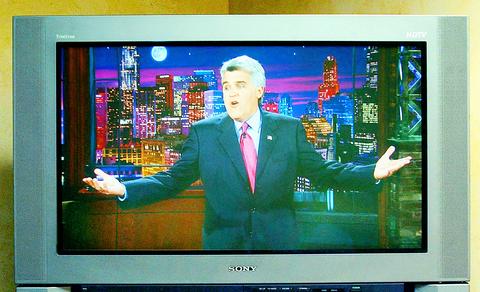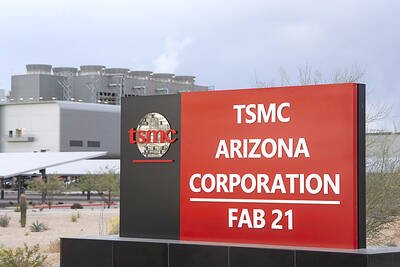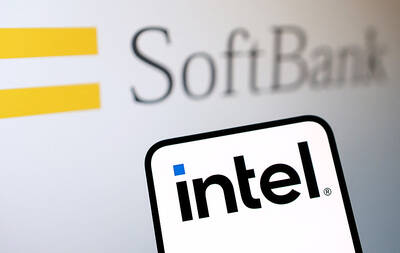After years as little more than a showpiece at electronics trade conventions, high-definition television is finally becoming practical. HDTV sets still don't qualify as basic appliances, but with prices as low as US$1,000, they're now within the realm of possibility for many consumers.
But here's the important question: When the gizmo is hooked up and ready to display its wide-screen, high-quality pictures, what will there be to watch?

PHOTO: NY TIMES
Until recently, the answer would have been: not much. For years, the technology had been caught in something of a Catch-22: the Federal Communications Commission pressured networks to broadcast more high-definition shows, but most networks were reluctant to spend the money on this programming because the manufacturers were not selling enough sets. For their part, manufacturers were unable to sell many sets because consumers were waiting for more shows to become available.
Today, the stalemate seems to be over. Now that prices have come down, the audience for high-definition television programs has grown, encouraging networks to increase the number of programs shown in the new format. As of last season, CBS and ABC were broadcasting all of their prime-time comedies and dramas in high definition. This coming season, NBC will broadcast 10 prime-time shows in the new format.
On Friday, the Federal Communications Commission voted 3-1 to require television set manufacturers to include digital tuners in new sets with screens of 13 inches or more by 2007. TV manufacturers, claiming the requirement will burden consumers with higher TV set prices, said they would appeal it in federal court.
PBS may have made the most headway in digital broadcasting. The public television network has been more inclined than commercial broadcasters to respond to the federal government's prodding, and as a result it was one of the first networks to broadcast HDTV. PBS has placed much of the emphasis on "Great Performances" and nature documentaries, which benefit greatly from HDTV's rich visual detail. A year ago "PBS was feeding us one new high-definition program a month; now they're averaging one or two a week," said Paula Kerger, station manager and vice president for development of WNET in New York.
With some shows, especially the three-camera sitcom, the difference between high-definition television and standard television might not be dramatic. "It's hard to say that that's a transforming experience," said Martin Franks, executive vice president of CBS.
But HDTV can greatly improve shows where immediacy and detail are important, like sports programming. High-definition television offers an especially sharp, clear picture, which gives viewers the sense that they are watching programs through a window. During a football game, for example, viewers may notice the sheen on a helmet or the spray of dirt unearthed by a speedy running back's cleats. The size and dimensions of the wide screen also allow the picture to include almost an entire half-court in a basketball game without reducing the players to the size of insects.
Despite HDTV's advantages, ESPN and its spin-off channels have not committed themselves to investing in high-definition equipment. Fox has taken an alternate route: It transmits digital programs in a format known as enhanced definition, which has a wide screen and an improved picture but is not true HDTV.
Fox's clever idea
Andrew Setos, Fox's president of engineering, argues that this less ambitious technology can generate more exciting sports broadcasts. "Other networks producing in high def," he said, "have fewer cameras, virtually no special effects, very limited graphics. So you end up with very sharp images but the production is quite dated -- let's call it 1960s television."
The other networks take issue with this. High-definition super slo-motion will be introduced this fall, said Franks of CBS. Other broadcast tools are also available, according to Preston Davis, ABC's president of broadcast operations and engineering. "All the hardware exists today to do a first-class, high-end HDTV sports production," he said.
HBO and Showtime offer their own high-definition channels, and serve up some of their popular dramas in high definition, including Showtime's "Odyssey 5" and HBO's "Band of Brothers" and "The Sopranos."
Both networks also transfer recent films to high definition. Turner Classic Movies, the leader in vintage Hollywood programming, has no immediate plans to take the technological leap into the new format, even though old movies would benefit from the format's greater detail.
Some new HDTV channels have emerged. Last September, Mark Cuban, owner of the Dallas Mavericks, introduced HDNet, available on the DirecTV national satellite system, which offers a variety of sports, news and documentaries. In June the Discovery Networks introduced Discovery HD Theater, featuring documentaries originally produced by the Discovery Channel, TLC, Animal Planet, Discovery Health and the Travel Channel. Currently, the satellite broadcaster EchoStar carries HD Theater for a separate monthly fee on its Dish Network, and three cable companies -- AT&T, Charter and Cox -- plan to offer it as well.
Of course, viewers' ability to see any of these channels depends on how they receive their signal. In many parts of the country, viewers with high-definition television sets and the appropriate decoder can watch programs on ABC, NBC, CBS, Fox and PBS over the air. New York City is one exception. The Sept. 11 attack destroyed the local digital transmitter that was beaming the signals for WNBC, WABC and WNET. Construction has not yet begun on a replacement. In July, WNET began transmitting in HD from a temporary tower in midtown Manhattan, but its reach is limited.
Channeling
For viewers who receive their signal by national digital satellite systems, DirecTV offers three high-definition channels, and EchoStar's Dish Network carries five. This fall, after the two companies complete their merger, the combined enterprise should provide as many as 12, according to Robert Mercer, a DirecTV spokesman.
Figuring out what programs are available on digital cable is a bit more complicated. Some cable operators -- including Charter, Cox and AT&T -- have added high-definition channels to their digital packages. A customer's location makes a critical difference. Time Warner in New York City offers five channels with high-definition programming -- WCBS, WNBC, WNET, HBO and Showtime -- while just a few miles away on Long Island, Cablevision transmits only three, HBO, MSG and the local Fox Sports cable channel.
Over the coming months, the next expansion of high-definition programming will depend upon the selling of decoders, which are required in order to receive high-definition channels. Some HD sets come with a decoder built into their circuitry, while others need to be hooked up to an external one. "If the market for decoders starts to accelerate," said Dale E. Cripps, publisher of HDTV Magazine, "then I think people on the broadcast side and the program-providing side are going to feel that there is a hit coming and they better get aboard."

Taiwan Semiconductor Manufacturing Co (TSMC, 台積電), the world’s biggest contract chipmaker, booked its first-ever profit from its Arizona subsidiary in the first half of this year, four years after operations began, a company financial statement showed. Wholly owned by TSMC, the Arizona unit contributed NT$4.52 billion (US$150.1 million) in net profit, compared with a loss of NT$4.34 billion a year earlier, the statement showed. The company attributed the turnaround to strong market demand and high factory utilization. The Arizona unit counts Apple Inc, Nvidia Corp and Advanced Micro Devices Inc among its major customers. The firm’s first fab in Arizona began high-volume production

VOTE OF CONFIDENCE: The Japanese company is adding Intel to an investment portfolio that includes artificial intelligence linchpins Nvidia Corp and TSMC Softbank Group Corp agreed to buy US$2 billion of Intel Corp stock, a surprise deal to shore up a struggling US name while boosting its own chip ambitions. The Japanese company, which is adding Intel to an investment portfolio that includes artificial intelligence (AI) linchpins Nvidia Corp and Taiwan Semiconductor Manufacturing Co (TSMC, 台積電), is to pay US$23 a share — a small discount to Intel’s last close. Shares of the US chipmaker, which would issue new stock to Softbank, surged more than 5 percent in after-hours trading. Softbank’s stock fell as much as 5.4 percent on Tuesday in Tokyo, its

COLLABORATION: Softbank would supply manufacturing gear to the factory, and a joint venture would make AI data center equipment, Young Liu said Hon Hai Precision Industry Co (鴻海精密) would operate a US factory owned by Softbank Group Corp, setting up what is in the running to be the first manufacturing site in the Japanese company’s US$500 billion Stargate venture with OpenAI and Oracle Corp. Softbank is acquiring Hon Hai’s electric-vehicle plant in Ohio, but the Taiwanese company would continue to run the complex after turning it into an artificial intelligence (AI) server production plant, Hon Hai chairman Young Liu (劉揚偉) said yesterday. Softbank would supply manufacturing gear to the factory, and a joint venture between the two companies would make AI data

DOLLAR SIGNS: The central bank rejected claims that the NT dollar had appreciated 10 percentage points more than the yen or the won against the greenback The New Taiwan dollar yesterday fell for a sixth day to its weakest level in three months, driven by equity-related outflows and reactions to an economics official’s exchange rate remarks. The NT dollar slid NT$0.197, or 0.65 percent, to close at NT$30.505 per US dollar, central bank data showed. The local currency has depreciated 1.97 percent so far this month, ranking as the weakest performer among Asian currencies. Dealers attributed the retreat to foreign investors wiring capital gains and dividends abroad after taking profit in local shares. They also pointed to reports that Washington might consider taking equity stakes in chipmakers, including Taiwan Semiconductor